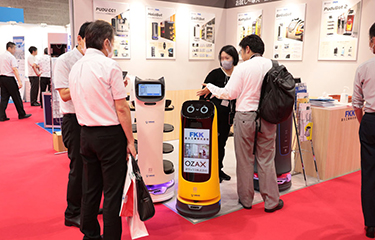Robotic waiters that can serve food, clean tables and floors, and display menu specials are catching the attention of Japan’s big sushi chains.
Column-shaped “robowaiters” made by Shenzhen, China-based Pudu Robotics were the center of attention at the Hoteres Japan trade show, which took place mid-summer in Osaka, signaling the continuance of a nationwide push that started during the Covid-19 pandemic to introduce more technology that encourages contactless dining around Japan. The trade show focuses on the Japanese hotel and restaurant industries, and the digitization of the restaurant industry was a prevalent theme at the show’s 16th edition.
Tokyo-based Fuji Industry Co. is the national Japanese representative for Pudu Robotics. The company and its subsidiary, Ozax Corporation, displayed several Pudu models at the show including the popular cat-themed robot, BellaBot, and a model with a large screen on the front called KettyBot, which can display menu specials or other messaging to customers.
Advertised prices of the two models in the U.S. have hovered around USD 16,000 (EUR 15,000) and USD 12,000 (EUR 11,000), respectively.
The other company showing off Pudu robots was Tokyo-based Japan Retail System, displaying other models such as the Holabot, which has a 60-kilogram weight capacity to bus dirty dishes when clearing tables, as well as the PuduBot – a simpler serving and delivery robot.
While Pudu Robotics makes the machines, these companies sell the robots and offer consultation services to buyers, such as surveying store layouts, steps, slopes, and aisle widths; demonstrating how the machines work; and conducting trial runs. After a sale, they also guide staff on the initial settings and operation of each robot and provide other after-sales services upon request.
Japan’s largest franchise restaurant operator, Tokyo-based Skylark, has implemented around 3,000 such robots in its Skylark and Gusto family restaurants, as well as its Shabuyo hotpot restaurants. Once loaded with plates of food by the staff, the robots navigate to their assigned tables, stopping for or going around customers moving in the aisles by using built-in sensors.
The BellaBot speaks to diners to tell them to unload their meal from the trays on which they come. When it sensesits trays are empty, it returns to the loading area.
Technology in this sphere was prevalent prior to the Covid-19 pandemic but rapidly ...
Photo by Chris Loew/SeafoodSource








